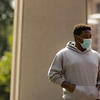The latest information on the spread of the coronavirus illness is available from the Centers for Disease Control and Prevention (CDC). The World Health Organization is also tracking the disease and offers advice for travelers.
COVID-19 FAQ Updated for Winter 2024
Below are a few links to help you find testing options. The best way to find a Covid-19 testing site is to check with your local or state department of health. Below are a few of the links for the surrounding states.
https://www.phila.gov/covid-testing-sites/
https://covid19.nj.gov/pages/testing
https://coronavirus.health.ny.gov/covid-19-testing
- Refer to CDC guidance in order to understand what your test result means and what kind of test you obtained.
- If you experience symptoms of COVID-19, you should begin isolation immediately, but you do not need to seek emergency medical care. Please see the CDC website for a list of possible symptoms.
- Seek emergency medical care immediately if you are experiencing more severe symptoms, including the following.
- Trouble breathing
- Persistent pain or pressure in the chest
- New confusion
- Inability to wake or stay awake
- Bluish lips or face
- Call 911 or call ahead to your local emergency facility and notify them that you may have COVID-19.
- Seek emergency medical care immediately if you are experiencing more severe symptoms, including the following.
- Isolate from others even if your symptoms are very mild. While the test is a useful diagnostic tool, the most important step you can take is to stop the spread of the disease. Stay home except to get emergency medical care and do not interact with other individuals. The updated Respiratory Virus Guidance (Including COVID-19) recommends that people stay home and away from others until at least 24 hours after both their symptoms are getting better overall, and they have not had a fever (and are not using fever-reducing medication). Note that depending on the length of symptoms, this period could be shorter, the same, or longer than the previous guidance for COVID-19. You can leave isolation when your symptoms are improving and you are fever free for 24 hours. You should wear a mask until 10 days after your tested positive or when your symptoms began.
- If you tested positive outside of Temple Student or Employee Health, go to Patient Health Portal and:
- Upload a copy of your COVID-19 test results.
- Once you upload your positive test, you will receive a message from Student and Employee Health Services with instructions.
If you have symptoms, test immediately.
If you are only going to take a single test, a PCR test will provide a more reliable negative test result.
If you use an antigen test, a positive result is reliable, it means you have Covid-19 infection, but a negative test is not always accurate.
To be confident you do not have COVID-19, the FDA recommends, 2 negative antigen tests for individuals with symptoms or 3 antigen tests for those without symptoms, performed 48 hours apart.
- If you experience symptoms of COVID-19, you should also begin isolation immediately, Please see the CDC website for a list of possible symptoms.
- Seek emergency medical care immediately if you are experiencing more severe symptoms, including the following.
- Trouble breathing
- Persistent pain or pressure in the chest
- New confusion
- Inability to wake or stay awake
- Bluish lips or face
- Call 911 or call ahead to your local emergency facility and notify them that you may have COVID-19
- Seek emergency medical care immediately if you are experiencing more severe symptoms, including the following.
- Isolate from others even if you have not yet received a COVID-19 test. While the test is a useful diagnostic tool, the most important step you can take is to stop the spread of the disease. Stay home except to seek emergency medical care and do not interact with other individuals. You will need to isolate until your symptoms are improving and for at least 24 hours after the resolution of fever and other symptoms without the use of fever-reducing medication. You should continue to wear a mask for an additional 5 days.
- A close contact is defined as being closer than six feet, for equal to or greater than 15 minutes to a person who has tested positive for or is presumed to have COVID-19 in a 24 hour period. If you are identified as a close contact or identify yourself as a close contact, it does not mean that you will develop symptoms for or test positive for COVID-19, but you most closely monitor yourself for the onset of symptoms. While being identified or self-identifying as a close contact is not an emergency, per se, it is very important that you take steps immediately to monitor your symptoms, get tested and limit interaction with those who are at high risk of severe disease.
- If you are experiencing symptoms for COVID-19, please refer to the guidance above and begin isolation.
- Per CDC guidance, close contacts of a known COVID-19 positive case should obtain a test five days following the last day of exposure to the positive case. Getting tested earlier greatly increases the chances that the test is not accurate and could be a false negative. If using rapid at home antigen tests, we recommend testing on day 5 and taking a 2nd test 48 hours later.

